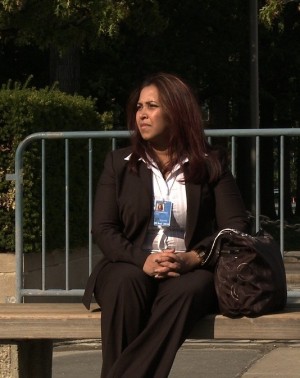Silent Voices Speak: The Real Sri Lanka Story
Lasantha Wickrematunge is probably not a name most people in the Western World would recognize. His martyrdom as the editor-in-chief of Sri Lanka’s critical newspaper, The Morning Leader was, unlike the parts that Hollywood trouble-seeking trailblazers like George Clooney or Matt Damon play, not a role he wanted. But Lasantha loved to tell the truth.
That insistence on making the world know what was really happening in his country made him an opponent of the government. It also caused him to be gunned down in broad daylight in the capital of Colombo by eight assailants a few days after his wedding. His widow, Sonali Samarasinghe, also a journalist and lawyer, was forced to leave Sri Lanka shortly after the killing. Silenced Voices, a New York premiere documentary recently presented as part of the Human Rights Watch Film Festival at Lincoln Center, is the story of Sonali’s exile and other journalists like her — seekers after truth, wandering the world like living ghosts, trying to tell a story that may never be heard in their own country.
The first image we have in Norwegian director Beate Arnestad’s stirring account is not one of the tortured exiles, but rather of Arnestad herself, crouched in the backseat of her guide’s car, staring out at the surrounding bush and the ramshackle shacks they pass along the roadside. She’s an attractive, fair-complexioned woman with a definite cinematic presence. Her first words, in Swedish with English subtitles, tell us this seems to be a cursed place where “nobody tells the truth.”
Arnestad’s destination this time is the camps, where huddled refugees fashion a hand-to-mouth existence for themselves. One woman, toothless and haggard beyond her years, has called this desolate place her home since the beginning of the conflict; another massages the deformed clumps of her little boy’s legs — his eyes not asking for sympathy, but simply grateful for the rare attention from a stranger. In another sequence, one of several videos the director managed to obtain, we hear shots of cluster shells. Civilians run helter-skelter for cover but there is none in these flat open areas of scrub and dry earth. Still another shows government soldiers, guns at rest, alongside a trench of dead bodies, some adults, others children. One journalist explains that the female corpses are often stripped of their clothing as a form of humiliation.
Harrowing images are intercut with Arnestad’s interviews with her journalist subjects. Night shots of Berlin’s railroad yards, long stretches of urban buildings with the camera in motion throughout the ride, give us a sense of flight. The deep-toned background music that undercuts this sequence effectively adds to the suspense. Bashana Abeywardane, another voice in hiding and given crucial support by PEN International, is seen sharing a video with Arnestad of a Tamil prisoner’s assassination by government forces.
In yet another scene, a middle-aged couple has been given asylum in Germany. Arnestad shows them seated on a city park bench. In their quiet limbo, they seem like two grown orphans with nowhere to go. The woman’s voice is desolate: “I don’t see a future here. We live day after day. Our shoes are not suitable for winter…We hope one day to go back.” Another individual, A. Lokeesan, is a handsome young man living undercover in India, another escapee from the country he has always known. At one point, the director tells the young journalist that Indian intelligence knows about her presence in the country and subsequently, she must relocate him quickly. When she shows a video of a young girl and her brother crouching over the body of their slain mother — the girl screaming, “What will become of us, we will be orphans!”— he rises, wiping his tears and turning away from the camera in the darkened room. There’s nothing left to say.
In this instance, Arnestad has made a risky but rewarding choice by letting her camera linger over a weighty moment. It is painful to watch, as are many moments in her film, but she is not about to soften her message for a viewer’s sensitivity.
To deliver a critical response to this documentary is bordering on the inconsequential, in the wake of the honesty and bravery of intent it manages to deliver to the audience. If anything, a European sensibility of cinema vérité, allowing the subtleties of facial expressions, muted responses from the subject in question to fill in the blanks, is a directorial trick if you will, to convey the truth of the moment. In the case of a documentary where such a large part of the Western world is unaware of the extent of Sri Lanka’s tragedy, a larger dose of history could have helped the situation.
Throughout the film, Sonali Samarasinghe is a palpable presence. From the carefree bride on her wedding day to Lasantha to her sobering day to day existence in New York City, stationed in front of the United Nations with its waving flags, she continues her search for justice. Will she be met with something other than deaf ears? “The UN is really a eunuch. It’s like an insider’s club. Sri Lanka is now at peace,” she bitterly remarks.
(Article continued on next page)

